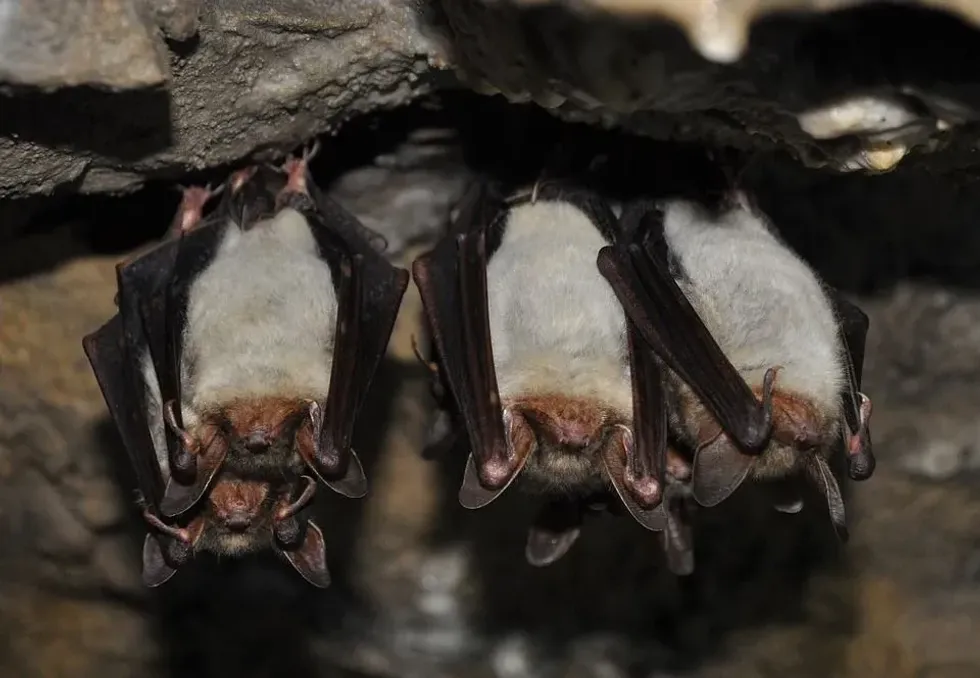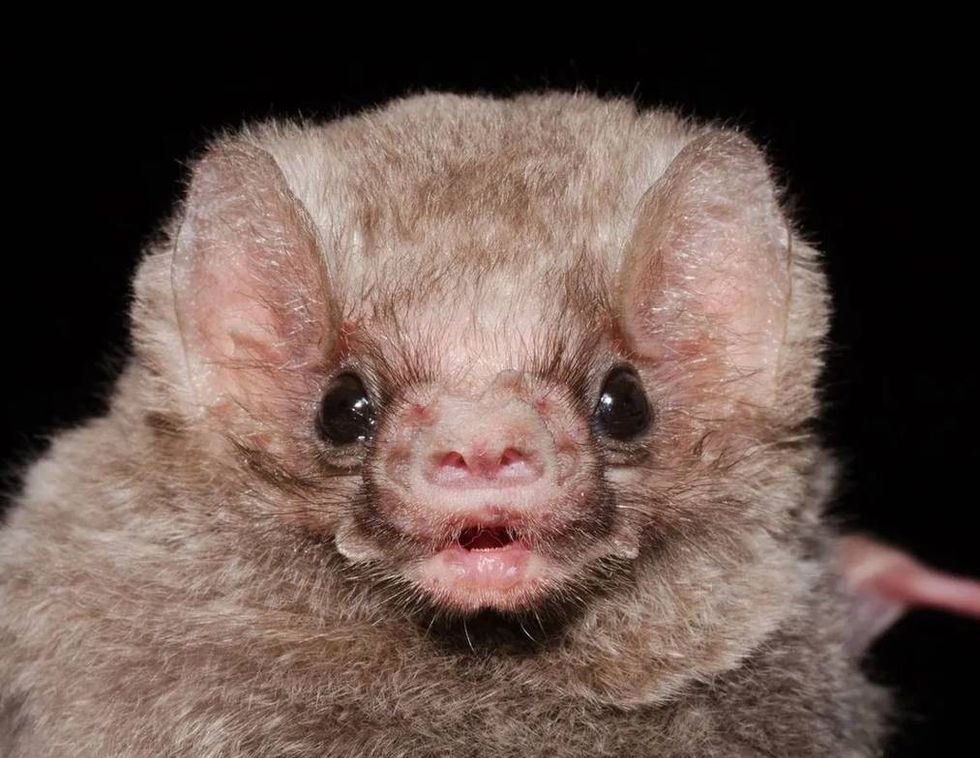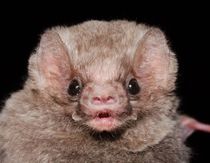Fun Vampire Bat Facts For Kids

Whatever terrifying images of a giant vampire bat we might conjure up when we first hear the term 'Vampire', thankfully, fact is far from fiction. To clear up that confusion once and for all we have for you some interesting facts about the legendary 'Vampire Bat', which might be the source behind all those terrifying mythical lores.
Vampire bats are a species of bat that is strictly sanguivorous, meaning, their diet consists only of blood.
There are three species of bats that make up the Desmodontinae subfamily, and they mostly prey on cows, pigs or for some species, birds. Although they feed on blood, they are rarely known for biting humans, actually they can be pretty docile and sometimes even friendly towards humans.
Their bites don't really hurt, but they can still be dangerous in the sense that they carry rabies and it can spread through bites. In the wild, they are known to live for about nine years, while in captivity some have survived for as long as 12 years.
Want to learn more about these interesting animals?
We suggest you keep reading on. And if you enjoy reading interesting articles, please check out our leopard seal and fennec fox.
Vampire Bat Interesting Facts
What type of animal is a Vampire Bat?
As evident by the name, they are members of the bat family that feed on blood.
There are three types of bats known to feed on blood found throughout Central and Southern America, such as, the White-winged Vampire bat, known for the white outlines on their wings, the Hairy-legged Vampire Bat, known for its furry legs and the Common Vampire Bat.
What class of animal does a Vampire Bat belong to?
Vampire bats are mammals, belonging to the Phylum Chordata, Order Chiroptera, Family Phyllostomidae and the Subfamily Desmodontinae.
How many Vampire Bats are there in the world?
Although they are very rare, just three of more than 1300 bat species living throughout the world, it is very hard to say just how many Vampire Bats there are. They are not listed as species of concern and are known to live in groups of large numbers.
Where does a Vampire Bat live?
Vampire Bats live in tropical and subtropical areas and are most commonly found all around Central and Southern America through Mexico up to Argentina. They can live in both humid and dry regions.
What is a Vampire Bat's habitat?
As they are nocturnal creatures, they spend most of the day sleeping in caves, hollow portions of trees, abandoned wells and sometimes even abandoned buildings in huge colonies.
Who do Vampire Bats live with?
They are social creatures, living in groups of more than 1000 individuals. Their social structure consists of groups of female vampire bats and their babies, some adult male vampire bats, who are called the 'resident males' as well as some other male vampire bats who are called the 'non-resident males'.
Unrelated female vampire bats are often known to join groups.
How long does a Vampire Bat live?
Wild vampire bats are known to live for about nine years in their natural habitat, but in captivity, they can live for up to 12 years.
How do they reproduce?
Unlike some other animals they are known to mate all throughout the year. Their gestation period is about three to four months, which is considerably longer compared to other species of small tropical bats.
After giving birth, the mother cares for the baby for 3-5 months until the baby is weaned. Vampire bats born in captivity are known to wean a lot later, at about nine months old.
As with other mammals the babies of vampire bats strictly feed on the milk of their mother until they are bold enough to feed on blood. Female vampire bats tend to be pretty caring as mothers, caring for and even often adopting young orphans in their group.
What is their conservation status?
Vampire bats are not enlisted as a species of concern, but they are often hunted by birds of prey, such as hawks and eagles and even snakes, who are known for eating bats, preying on them in the daylight hours when they are often sleeping.
Their main threat are humans, who use a special kind of chemical known as vampiricides to protect their livestock.
This poison when consumed by one vampire bat can spread throughout the colony through their habit of social grooming.
Vampire Bat Fun Facts
What do Vampire Bats look like?
The common vampire bat, scientific name being Desmodus rotundus, has very short fur, ranging from silver-grey on the undersides of its body to a richer velvety brown on its back.
The common factor for all the three species of vampire bats is their leaf-shaped nose, but the groove on the lip differs in location for each.
The differences in their appearance is also noticeable, as the Hairy-legged vampire bats, also known as Diphylla ecaudata, has longer fur which is heavily distributed in their legs, and longer ears and shiny, large black eyes.
The white-winged vampire bats, also known as Diaemus youngi are different from the white outline of their wings as well as the skin between their third and fourth fingers.

How scary are they?
Whatever mythical lores and their sparkling pop-culture version would have us believe about the legendary vampires or their animal counterpart, the vampire bats, the truth is far from anything like that. Do not be fooled by their razor-sharp teeth or their habit of swarming around in terrifyingly large groups.
In reality, they can be pretty tame and in some cases even friendly to humans. So, no, they are not scary at all.
How do they communicate?
Vampire bats are as vocal as much as they are social in nature. They use vocal sounds to call out their offsprings and other group members.
There is a difference in the frequency of each of their 'calls', enabling them to identify different individuals.
The mothers and babies are known to call out to each other when they are about to feed on their liquid diet of blood or sometimes the babies will even call out when they are trying to find their mother.
They also portray touch and chemical traces to be an integral part of the communication process. They also seem to use echolocation, olfaction as well as auditory signals to help them identify and navigate their prey.
How big is a Vampire Bat?
A common vampire bat is about 2.75-3.75 in big with a wingspan of about 5.9 in - 7 in long, which is even smaller than a Barbados threadsnake. As an adult, a vampire bat almost never grows bigger than a little teacup, making them one of the smallest mammals to ever exist.
How fast can a Vampire Bat move?
Common vampire bats can move as fast as 8.58 mph, which is about the same speed as of a chicken.
How much does a Vampire Bat weigh?
They are very light, weighing at about 0.04-0.12 lb, which enables them to fly quickly away from danger. Although after a feeding the weight of a vampire bat can increase more than half of what it initially was, their quick digestion system helps them with their mobility.
What are their male and female names of the species?
Vampire bats do not really have gender-specific names for their male and female counterparts, they are just known as male vampire bats and female vampire bats.
What would you call a baby Vampire Bat?
Like some other mammals, the babies of vampire bats are also called pups.
What do they eat?
Vampire bat pups are known to feed strictly on their mother's milk until they are old enough to consume the adult liquid diet of blood.
After a 30 minute feeding their weight almost doubles and it gets tough for them to fly away. A vampire bat colony can drink almost the blood of up to 25 cows in a single year.
The common vampire bat colonies are known to consume the blood of mammals primarily, but both Hairy-legged vampire bat and White-winged vampire bat consume the blood of birds primarily.
As a vampire bat can only last for about two days without blood, they will often plead other bats of their group to share the food with them. After their approach through social grooming, the donor bat will then disgorge a little amount of blood, saving the life of their fellow member.
Donor bats are also known to often initiate the blood sharing process.
Are they dangerous?
Even though the vampire bat is not usually aggressive, and are often pretty docile around humans, they can still be dangerous as they carry a disease called rabies, which harms the livestock which they are known to prey on.
Would they make a good pet?
Even though it is legal to own a vampire bat as pet in some parts of the United States, it not really advisable, as they are wild creatures who do not do well in isolation and need lots of space to explore and fly around freely.
Since it is not possible to create that kind of environment in our houses, it is not really healthy for them to be kept in captivity.
Did you know...
These fascinating creatures although rare are thankfully not in danger of going extinct as of yet, though large birds of prey and snakes have the habit of eating bats, the main threat to them is actually humans.
Their diet, carnivorous in nature, consists only of feeding on flowing blood. Only in the dead of night do the bats emerge from their hideouts in hollow trees and caverns.
There are only three bat species known to drink blood, and vampire bat is a common name used to indicate all three of them.
Do vampire bats bite humans?
Although the source of the liquid diet for common vampire bats is primarily mammals, they are rarely known to bite humans. Their bites are not painful and as they rarely carry diseases like rabies, it is also not particularly harmful.
But just to be safe, it is better to get a shot of the vaccine if you have indeed been fed on.
What are some interesting facts about vampire bats?
As interesting as they are, here we have a few more fun facts about vampire bats that will feed your curiosity. Did you know that vampire bats feed only on flowing blood? They do not suck blood from their prey, rather puncture the skin with their front teeth and lap up the blood that comes out of it.
Their front teeth do not have enamel which keeps them razor sharp forever. Literally! Even in museums, people have to very careful while handling a vampire bat skull, as the teeth can injure you even then.
They are only found throughout Central and South America, making them very rare.
Female vampire bats make really caring mothers, and they are known to adopt orphans.
The baby vampire bats feed only on their mother's milk as well as cling to them until they are old enough to venture out on their own.
Vampire bats can even run, walk or hop around which is extremely rare for bats. They even have a very strong thumb and hind legs helping them to fly away from their prey after feeding on their blood.
After biting their prey with their teeth, their saliva helps them to keep the prey's blood flowing for longer with its anticoagulant components.
Here at Kidadl, we have carefully created lots of interesting family-friendly animal facts for everyone to discover! Learn more about some other mammals including giant anteater, or plains zebra.
You can even occupy yourself at home by drawing one on our Vampire Bat coloring pages.
We Want Your Photos!
More for You
See All
Bachelor of Arts specializing in Journalism and Mass Communication, Postgraduate Diploma in Sports Management

Moumita DuttaBachelor of Arts specializing in Journalism and Mass Communication, Postgraduate Diploma in Sports Management
A content writer and editor with a passion for sports, Moumita has honed her skills in producing compelling match reports and stories about sporting heroes. She holds a degree in Journalism and Mass Communication from the Indian Institute of Social Welfare and Business Management, Calcutta University, alongside a postgraduate diploma in Sports Management.
Bachelor of Arts specializing in English Literature

Deeti GuptaBachelor of Arts specializing in English Literature
A detail-oriented fact-checker with a research-oriented approach. Devika has a passion for creative writing, she has been published on multiple digital publishing platforms and editorials before joining the Kidadl team. Currently pursuing a Bachelor of Arts in English Literature from St.Xavier's College, Deeti has won several accolades and writing competitions throughout her academic career.
Disclaimer
1) Kidadl is independent and to make our service free to you the reader we are supported by advertising. We hope you love our recommendations for products and services! What we suggest is selected independently by the Kidadl team. If you purchase using the Buy Now button we may earn a small commission. This does not influence our choices. Prices are correct and items are available at the time the article was published but we cannot guarantee that on the time of reading. Please note that Kidadl is a participant in the Amazon Services LLC Associates Program, an affiliate advertising program designed to provide a means for sites to earn advertising fees by advertising and linking to Amazon. We also link to other websites, but are not responsible for their content.
2) At Kidadl, we strive to recommend the very best activities and events. We will always aim to give you accurate information at the date of publication - however, information does change, so it’s important you do your own research, double-check and make the decision that is right for your family. We recognise that not all activities and ideas are appropriate for all children and families or in all circumstances. Our recommended activities are based on age but these are a guide. We recommend that these ideas are used as inspiration, that ideas are undertaken with appropriate adult supervision, and that each adult uses their own discretion and knowledge of their children to consider the safety and suitability. Kidadl cannot accept liability for the execution of these ideas, and parental supervision is advised at all times, as safety is paramount. Anyone using the information provided by Kidadl does so at their own risk and we can not accept liability if things go wrong.
3) Because we are an educational resource, we have quotes and facts about a range of historical and modern figures. We do not endorse the actions of or rhetoric of all the people included in these collections, but we think they are important for growing minds to learn about under the guidance of parents or guardians.







